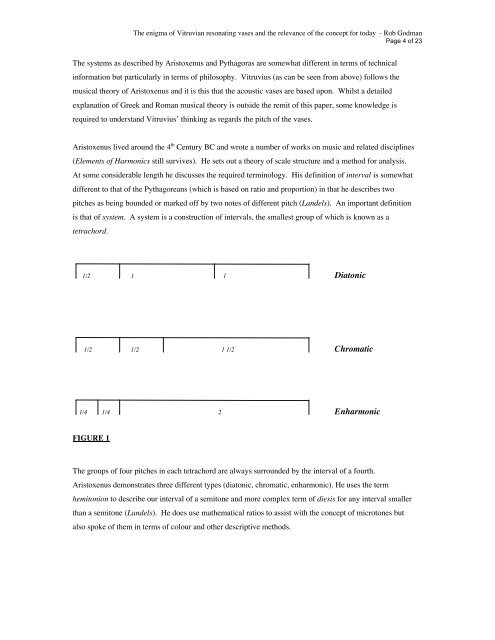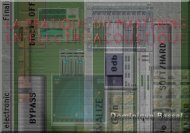The enigma of Vitruvian resonating vases and the relevance ... - CEC
The enigma of Vitruvian resonating vases and the relevance ... - CEC
The enigma of Vitruvian resonating vases and the relevance ... - CEC
Create successful ePaper yourself
Turn your PDF publications into a flip-book with our unique Google optimized e-Paper software.
<strong>The</strong> <strong>enigma</strong> <strong>of</strong> <strong>Vitruvian</strong> <strong>resonating</strong> <strong>vases</strong> <strong>and</strong> <strong>the</strong> <strong>relevance</strong> <strong>of</strong> <strong>the</strong> concept for today - Rob Godman<br />
Page 4 <strong>of</strong> 23<br />
<strong>The</strong> systems as described by Aristoxenus <strong>and</strong> Pythagoras are somewhat different in terms <strong>of</strong> technical<br />
information but particularly in terms <strong>of</strong> philosophy. Vitruvius (as can be seen from above) follows <strong>the</strong><br />
musical <strong>the</strong>ory <strong>of</strong> Aristoxenus <strong>and</strong> it is this that <strong>the</strong> acoustic <strong>vases</strong> are based upon. Whilst a detailed<br />
explanation <strong>of</strong> Greek <strong>and</strong> Roman musical <strong>the</strong>ory is outside <strong>the</strong> remit <strong>of</strong> this paper, some knowledge is<br />
required to underst<strong>and</strong> Vitruvius’ thinking as regards <strong>the</strong> pitch <strong>of</strong> <strong>the</strong> <strong>vases</strong>.<br />
Aristoxenus lived around <strong>the</strong> 4 th Century BC <strong>and</strong> wrote a number <strong>of</strong> works on music <strong>and</strong> related disciplines<br />
(Elements <strong>of</strong> Harmonics still survives). He sets out a <strong>the</strong>ory <strong>of</strong> scale structure <strong>and</strong> a method for analysis.<br />
At some considerable length he discusses <strong>the</strong> required terminology. His definition <strong>of</strong> interval is somewhat<br />
different to that <strong>of</strong> <strong>the</strong> Pythagoreans (which is based on ratio <strong>and</strong> proportion) in that he describes two<br />
pitches as being bounded or marked <strong>of</strong>f by two notes <strong>of</strong> different pitch (L<strong>and</strong>els). An important definition<br />
is that <strong>of</strong> system. A system is a construction <strong>of</strong> intervals, <strong>the</strong> smallest group <strong>of</strong> which is known as a<br />
tetrachord.<br />
1/2 1 1 Diatonic<br />
1/2 1/2 1 1/2 Chromatic<br />
1/4 1/4 2 Enharmonic<br />
FIGURE 1<br />
<strong>The</strong> groups <strong>of</strong> four pitches in each tetrachord are always surrounded by <strong>the</strong> interval <strong>of</strong> a fourth.<br />
Aristoxenus demonstrates three different types (diatonic, chromatic, enharmonic). He uses <strong>the</strong> term<br />
hemitonion to describe our interval <strong>of</strong> a semitone <strong>and</strong> more complex term <strong>of</strong> diesis for any interval smaller<br />
than a semitone (L<strong>and</strong>els). He does use ma<strong>the</strong>matical ratios to assist with <strong>the</strong> concept <strong>of</strong> microtones but<br />
also spoke <strong>of</strong> <strong>the</strong>m in terms <strong>of</strong> colour <strong>and</strong> o<strong>the</strong>r descriptive methods.








